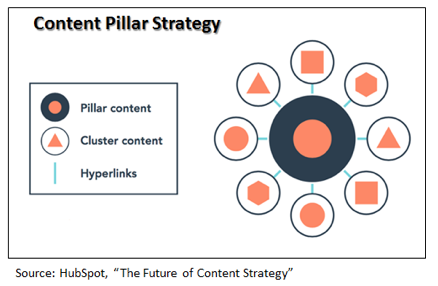How to Sell a Content Marketing Program to the Boss

This past week, I had a very interesting conversation with a seasoned professional services marketer about content marketing. Usually when I talk to marketers and Managing Partners about content marketing, we focus on the issue of how to get a content marketing program launched and sustained, and the resources required for getting an ROI on the expenditure.
But this case was a little bit different.
Her concern was not about getting partner and subject matter experts engaging in developing content, it was about what to do with the inventory on hand. My observation was that their next move would be to gate some portion of that content for lead generation (i.e. using a form), and to consider a contextual marketing strategy and marketing automation to move leads though the sales funnel from prospect to engagement.
That did not sit very well.
Sleazy. Cheap. Undignified. Beneath our professional standards. And my favorite, “salesy”.
With that attitude and perception, there’s little (if any) wiggle room to build a content marketing program on best inbound marketing practices for lead generation. Content marketing then becomes a tactic for corporate and personal brand building, and there’s nothing wrong with that.
My option: most professional service firms want both branding and a demonstrable ROI on their investment in content marketing and where there’s a will, there’s a way.
Dealing with the Misconceptions of Content Marketing
If you are at a stage where you need to sell inbound marketing and a content marketing program to your boss, or are looking for more budget, I want to recommend two articles for your consideration:
- How to Fix 9 Harmful Misconceptions about Content Marketing by Stephen Moyers, published on Content Marketing Institute’s blog.
- 12 Common Misconceptions about Content Marketing by Susanna Gebauer, published on the Jeff Bullas blog.
While they discuss a number of key misconceptions, there are three in particular that we’ll always hear when discussing putting inbound marketing into play:
(1) Content marketing is easy and cheap
It’s not and it isn’t. Content marketing requires a combination of resources, commitment and dedication in order to have a chance at success. What makes it particularly hard in professional service firms is a seemingly unsurmountable speed bump at the intersection of competition for use of unbillable time and entrenched and often antiquated notions of the best ways to build a practice. Regardless of all of merits and good intentions it’s impossible to force a partner into becoming a “visible expert” if the inclination and desire isn’t there.
You have to want it and the firm has to support it with time, money and other resources.
(2) Content’s marketing value is not measureable
Perhaps this was true in the old days, but in a digital era, everything is measureable. In fact, firm’s should not dive into content marketing without niche specific plans that have measureable goals. These can include: (1) content consumption metrics like page visits and views, (2) social media interactions, and (3) conversion statistics like website visitors to leads and engagements.
(3) Content marketing delivers instant results
One of the most difficult jobs that any marketer has is to manage expectations. This is particularly true relative to content marketing programs, where expectations that one content piece will result automatically in a sale simply aren’t true. A successful content marketing program – one that delivers more visibility, leads and sales – is the result of persistence, dedication and patience.
There are some great insights in these blog pieces and they’ll be of great help to you when framing your argument or position to the powers that be. When you take their insight along with our offer (see below) for statistics on content marketing,, you should have a great foundation for making your case.
It’s all About the ROI of Content Marketing
After dealing with misconceptions, when all is said and done however, the marketing team will still need to frame an argument for making a commitment and investment into content marketing in terms of return on investment.
While you may desire to build your own set of ROI KPI’s, a great starting point is the following graphic from the latest Content Marketing Institute B2B Benchmark Report.
An interesting note: while you might think that “sales” was the number one KPI, it appears that increases in website traffic take the top spot. Think about it for a moment: better content means more opportunities for more traffic to the website, and more traffic to the website means more opportunities for lead generation conversations, and ultimately, more sales.
And the recommendation was...
 Now, back to the story of the firm who wouldn’t.
Now, back to the story of the firm who wouldn’t.
The solution for this firm’s marketing team – which may also be appropriate for your firm – is to offer inbound marketing services only to those niches that want it, understand it, and will give a commitment to an inbound program. In other words, don’t create a firm-wide inbound marketing program, do it on niche by niche basis.
In all of the work we do for our professional services clients – especially CPA firms – we’ve found that working at the niche practice level is the single most effective way to put in a new marketing playbook.
We don’t try to convince all of the partners in the firm to move into inbound marketing. We only want to work with those partners and those niches that want a new marketing playbook without being forced to adopt a marketing approach that will be doomed to fail because of partner recalcitrance or (and we’ve experienced and seen this) partner hostility.
What happens is that after showing success, other niche practice leaders start to get curious, and over time, turn their curiosity into commitment.
At the end of the day, inbound marketing is only “salesy” if you make it so. If you have great thought leadership and content that speaks to prospect pain points and issues, those prospects will not hesitate to fill out a form do a download. It’s a combination of intellectual capital and art and science and technology that makes inbound marketing work.
In other words, stray away from the “buy one audit get one audit free” offer!
.png)







Leave a Comment